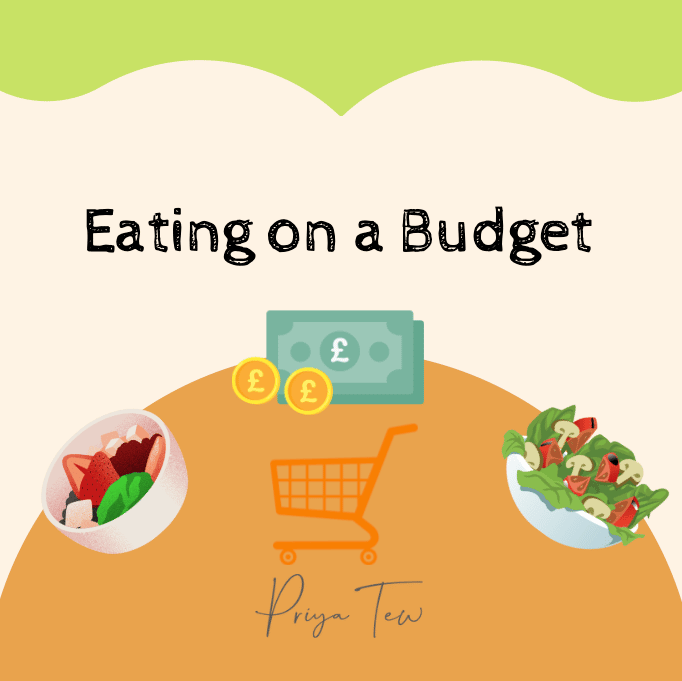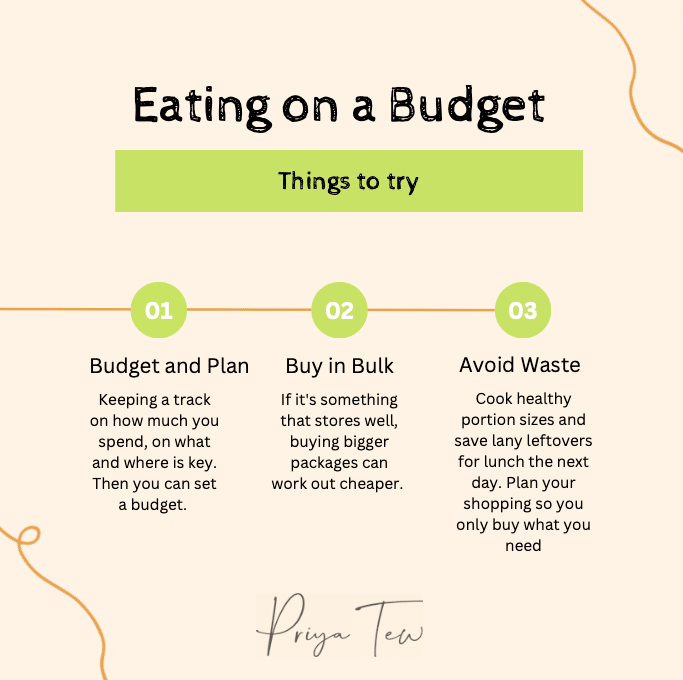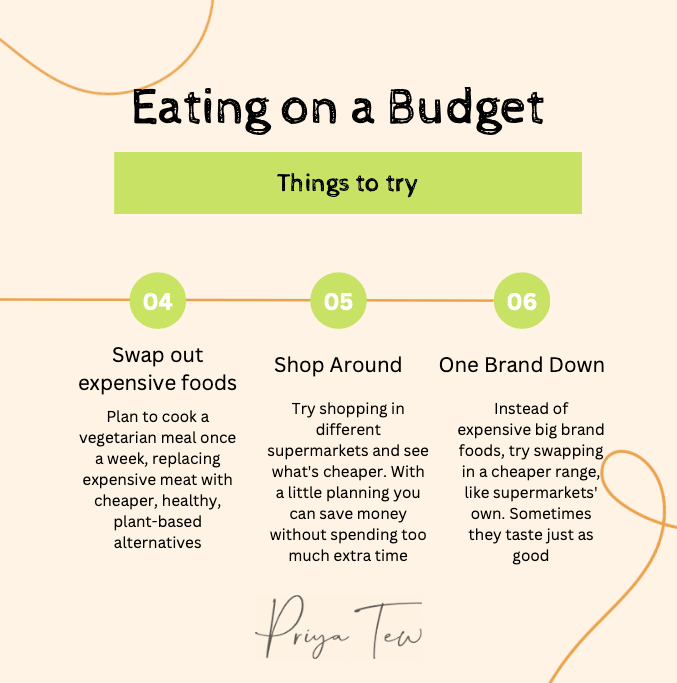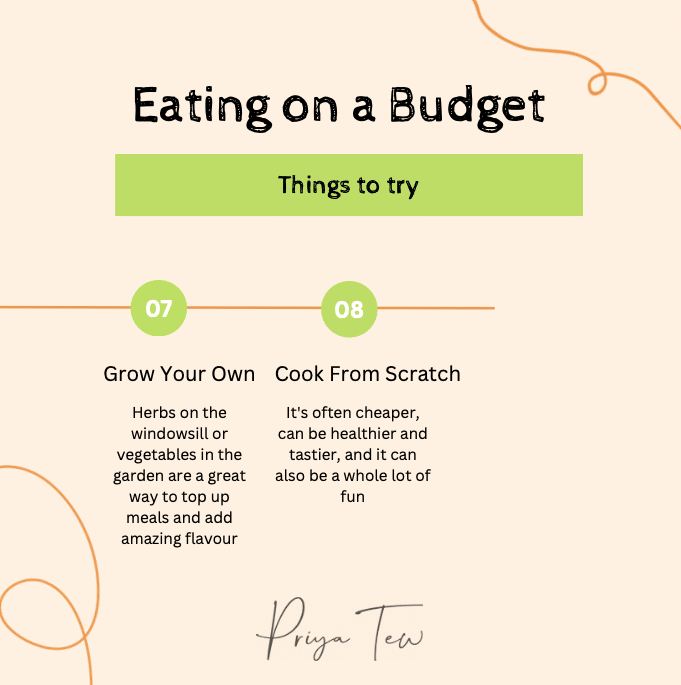How to budget shop for food
Prices are soaring, be it for petrol, gas, food or electricity, so how can you food shop on a budget and keep costs low. So what can you do to make your money stretch as far as possible when it comes to feeding yourself/your family? Nutrition is important for our long term health, so whilst money saving is key you don’t want to cut out key foods and nutrients. If you are working on eating disorder recovery (a key area I specialise in), then this is even more important. Nutrition is vital for health, but there are some tips I can share to help.

Keep those reciepts to cut costs:
This one isn’t glamorous, can be tedious and boring, but can definitely help in keeping costs manageable. If you’ve never budgeted for your groceries and have no idea how much you usually spend each week/month, keep those receipts for a while and add them up. You might be pleasantly surprised; you might be shocked but find things you can swap/cut down on.
When budgeting, think about the meals you want to make, how much you usually eat, and don’t forget to include those fun foods too. Food is not just for nourishment, it also brings us pleasure. Think about how much you can afford to spend on food each month? Make some meal plans for the week that suit your budget. Whether you set an itemised list or just keep a general monthly total, keeping an eye on your overall spend can inform your shopping choices and maybe free up pennies for some special items too.
Think about the food that cost the most on your shopping receipt. Are there any you can swap for a different brand or use something else instead? Maybe it’s that expensive olive oil or the granola for breakfast. Whilst we all need some luxury foods there can also be some tweaks to make.
Save on pennies by buying in bulk:
For most things, bigger means cheaper. Or there can be offers when you buy several items (think 3 for 2 offers). If you’re buying products that have a long shelf-life (such as tins, frozen foods, pasta and rice) then the larger packets are often better value. Most supermarkets have a “price per kg” or “price per ml” written under the price of the packet. So take a look and see if you can save. Try keeping a list on your phone of prices per kg/100g for the core products you use then compare when shopping. It sounds ultra organised but it soon sticks in your head. It is also something to try not to become totally obsessed over, tracking and comparing can be a delicate balance but it does beat comparing the calories on packets!
Ideal things to buy in bulk: sacks of rice, larger packs of cheese which can be grated and frozen, frozen foods, larger bags of pasta, boxes of cereal bars and snack items, larger pots of yoghurt to decant into pots.
Look out for shops where you can buy in bulk, places like CostCo and Cash and Carry. These aren’t always cheaper so do price compare. Often these shops are cheaper for branded foods but these foods are not necessarily cheaper compared to own brands. You can also bulk buy from warehouses online, for example Bulkco and even Ebay.
Be careful though, if buying more makes you cook more, then any saving is lost in waste or extra eating! Avoid buying in bulk if you aren’t sure you will eat it all before the food goes off. Or if you do then why not share items with friends? Start a food co-op with a small group and if you’re doing a bulk buy see who else wants to share it.

Cut down food waste to free up cash:
This seems obvious, but a huge amount of food is wasted every year in the UK because we buy too much or cook too much. Buy only what you need and what you can eat, before it spoils. Planning your meals for the week before shopping can make sure you have the right ingredients, and you know when items will be used, making sure they’re not left to go bad in the fridge. This doesn’t mean you have to fall into the “clean plate club” and feel the need to eat everything you cook. You can still eat intuitively, but instead…
Cook senisble portion sizes and save any leftovers for another meal. If the leftovers aren’t big enough for an extra meal, then try these ideas:
Add leftovers to the next meal, it can actually make a meal tastier.
Have leftovers on toast for your lunch the next day.
Make a “hodgepodge” meal of all the leftovers at the end of the week. When I was growing up this was called TIAILO (Throw it all in leftovers).
Cook jacket potatoes and use the leftovers up as toppings.
Use leftover veggies in bubble and squeak.
Freeze it for another day.
Add more plant based meals in:
Meat and fish can be very expensive, but also very nutritious providing protein, iron, zinc and B12. So you don’t necessarily want to cut it out. Why not try using cheaper cuts, buy a whole chicken and roast it, keep the leftovers for stir fries and pasta dishes. Buy larger portions of mince and freeze half the pack, try frozen fish. Having some vegetarian or plant based meals in your week can also be cost saving and also great for the environment too.
Lentils and beans are a great source of protein and can easily replace mince in a curry, bolognaise or shepherds pie. Many vegetables also remain quite cheap and so planning in some vegetarian dishes each week can save quite a few pennies. If you do choose to cut out meat and fish totally then make sure you replace it with healthy alternatives. This ensures a nutritionally-balanced diet.
Some ideas: lentil bolognaise (this also uses up those laguishing veggies at the bottom of the fridge), vegetable egg fried rice, broccoli and cauliflower cheese pasta bake, butternut squash curry, or try a simple pepper and mozerella pasta.

Shop Around for Offers:
We all have our favourite place to shop. Maybe it’s where your parents always went when you were growing up. Maybe it’s the closest supermarket or a corner shop a few doors away. It’s still worth looking in a few different shops to see if you can pick up your favourite items for less. Special offers will be different from store to store, and if you can pop in when you’re passing anyway, you might find it’s worth the extra effort.
As with buying in bulk, don’t let yourself get sucked in by special offers. Is it something you need, or is it an impulse buy? Is it more than you can use before the food goes bad? Just because something is on offer, doesn’t mean it will save you money. Expensive brands, even on offer, can still be more pricey than cheaper brands. And, if you keep an eye out, you might even see an offer that isn’t really an offer (e.g. 50p each or three for £1.50) – sneaky tricks supermarkets use to make you spend more money!
Take a look for out of date warehouses. This may sound strange but there are shops now that sell food near its best before date. This is a way of stopping that food going to landfill and saving you some pennies. We love the Company Shop for bread, yoghurts, meat and vegetables. There are various online warehouses that sell dried goods and snack items near their best before dates, such as approved food or low price foods. Just be careful to only buy what you know you will eat, try sharing a delivery with friends.
One Brand Down:
You might have come across this idea before. But it remains a good experiment to try out in the search for savings. All of us will have our favourite brands for various foods. Be it Heinz baked beans or Kellogg’s cornflakes, or just a supermarket’s own label, we’ve always bought them and love the flavour. But are they always the best value for money? Or the best value for taste?
Most supermarkets will have three or four “ranges”.Big-name brands at the top, then the supermarket’s own Premium range. Next it’s supermarket’s own standard range, and then a supermarket’s own Budget range. The idea of One Brand Down is to try out a product from one range lower. Do you buy a Big Brand or Premium tin of beans? Try out the standard tin. If you buy standard cereals, try out the budget range. Sometimes (but definitely not always) you’ll find that the cheaper brand range is just as tasty as the expensive one! We’re all allowed our luxuries, however, so, if you really prefer your Kellogg’s cornflakes, it’s fine to stick with Kellogg’s.
Grow Your Own:
If you’re lucky enough to have a good-sized garden then a vegetable patch can provide plenty of food to top up your cooking. Fresh salad leaves, herbs, beans and tomatoes, are great things to plant and enjoy in the summer months. If you don’t have much outdoor space then try growing some herbs on the windowsill. This can help add some great fresh flavours to your dishes. Very few people will have the space, or time, to live off their own produce. However, once a vegetable garden is established then there are very few ongoing costs involved.

Cook From Scratch:
My final tip for saving money will fill some with terror, but it’s really not that difficult. Cooking from scratch can be very rewarding, fun, and I personally think it tastes so much better! But why cook from scratch?
It is often cheaper – ready-made sauces in jars are usually more expensive than a tin of tomatoes and some herbs and vegetables
It’s healthier – a lot of ready-made foods include a lot more added salt, fat, and/or sugar than when you make it yourself. And you can certainly make great-tasting food with little or no added salt/sugar/fat
It’s tastier – the best tip for cooking: have a big herb and spice rack. Explore the multitude of flavours by experimenting. Mix and match and find out what you like. Most herbs and spices are cheap (and you can grow your own herbs quite easily too) and they can allow you to cook the same ingredients but end up with two different tasting dishes
It’s fun – okay, not everyone might agree, but a lot of joy can be found in cooking from scratch, serving up a meal, and watching friends and family enjoy it. And whether it’s boiling, roasting, baking, frying or pouching, it’s just not as scary or as difficult as you might think! With a bit of practice you can soon find yourself loving your time cooking
What can you use to cook from scratch?
Fresh vs Frozen vs Tinned – Use all three! There are great reasons to use each, and whilst you might assume that fresh is always best, that isn’t the case. Frozen fish and vegetables are great examples of how the frozen variety can often be better. These foods are frozen within hours of being caught/picked and so are actually more fresh than the fresh equivalent! Tinned beans or tomatoes are perfectly good to use in your cooking, and (just like frozen) they keep far longer than fresh foods, which can help you cut down on waste, and therefore on your costs.
Lastly you can also think about energy saving to help reduce overall costs. Efficiency is the name of the game: combine all your veg into one pan, instead of heating three; make a great-tasting tray-bake, cooking everything together; get those portion sizes right and only cook what you need, or cook enough for a meal of leftovers the next day; if you’re using the oven for dinner, bake at the same time instead of re-heating the oven at another time. Lots of little changes will soon add up!